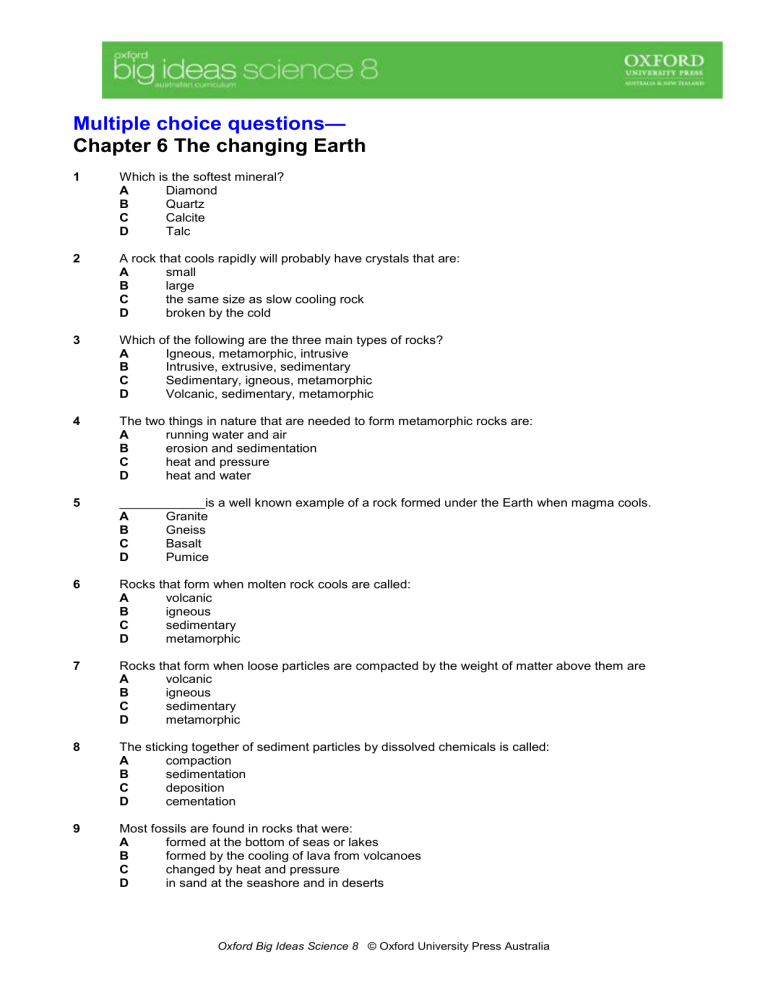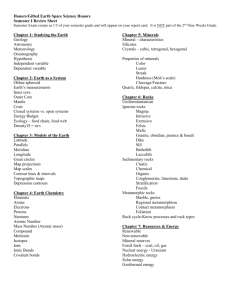S8_MCQ_06

Multiple choice questions —
Chapter 6 The changing Earth
1
2
3
4
5
6
7
8
9
Which is the softest mineral?
A
B
C
D
Diamond
Quartz
Calcite
Talc
A rock that cools rapidly will probably have crystals that are:
A small
B large
C
D the same size as slow cooling rock broken by the cold
A
B
C
D
Which of the following are the three main types of rocks?
A
B
C
D
Igneous, metamorphic, intrusive
Intrusive, extrusive, sedimentary
Sedimentary, igneous, metamorphic
Volcanic, sedimentary, metamorphic
The two things in nature that are needed to form metamorphic rocks are:
A
B running water and air erosion and sedimentation
C
D heat and pressure heat and water
____________is a well known example of a rock formed under the Earth when magma cools.
Granite
Gneiss
Basalt
Pumice
Rocks that form when molten rock cools are called:
A volcanic
B igneous
C
D sedimentary metamorphic
Rocks that form when loose particles are compacted by the weight of matter above them are
A
B
C
D volcanic igneous sedimentary metamorphic
The sticking together of sediment particles by dissolved chemicals is called:
A compaction
B sedimentation
C
D deposition cementation
Most fossils are found in rocks that were:
A
B
C
D formed at the bottom of seas or lakes formed by the cooling of lava from volcanoes changed by heat and pressure in sand at the seashore and in deserts
Oxford Big Ideas Science 8 © Oxford University Press Australia
The next two questions (10–11) refer to the following table.
10
11
12
13
14
15
Appearance
‘Ingredients’
Fossils
How it’s made
Original rock
Limestone
Grey, dull
Slightly hard
Slightly rough
Calcium carbonate
Little shells
Formed by sedimentation over marine animals
Metamorphic rock
Marble
White, shiny
Very hard
Smooth feel
Calcium carbonate
Little shells changed by heat and pressure
Original rock
Granite
Light and dark
Hard
Rough feel
Biotite, quartz, feldspars
None
Liquid rock called magma solidified
Which statement is a conclusion that can be drawn from the data in the table?
A The appearance of a rock is not changed by heat and pressure.
B
C
When rocks are changed into metamorphic rocks they become rougher.
Heat and pressure cause fossils to form.
D Being affected by heat and pressure does not change the ingredients of a rock.
What type of rock is limestone?
A Metamorphic
B Sedimentary
C
D
Intrusive igneous
Extrusive igneous
Metamorphic rock
Gneiss
Dark, shiny
Hard
Slightly rough
Mainly biotite, feldspars, quartz
None
Changed by heat and pressure
Fossils of dinosaur footprints or bones have not been found in rocks that are less than 65 million years of age. What is the likely cause of this?
A
B
The rocks were buried too deep so as yet the fossils have not been discovered.
The rocks were too close to the surface and any fossil evidence has been destroyed by
C
D weathering and erosion.
There were no dinosaurs at that time.
The ice age destroyed all fossil evidence at this time.
Limestone and coal are sometimes called ‘biological’ sedimentary rocks. Why do you think this happens?
A
B
They contain fossils of living things.
They are made from bones of animals.
C
D
They are both formed by the deposition of material that was once living.
They are both formed in river beds or marine environments.
Radioactive dating of rock samples is:
A
B
C
D a method of absolute dating a method of comparative dating able to give the exact age of a rock used to create a geologic time scale
The underlying concept of the rock cycle is the idea that:
A rocks can be moved from place to place on the earth without changing
B
C igneous rocks may be re-melted several times rocks are continually subject to change
D any type of rock may be transformed into another type by appropriate processes
Oxford Big Ideas Science 8 © Oxford University Press Australia








